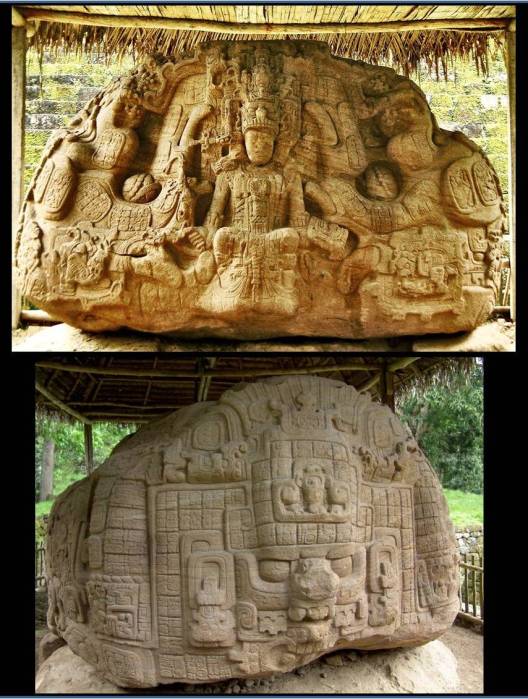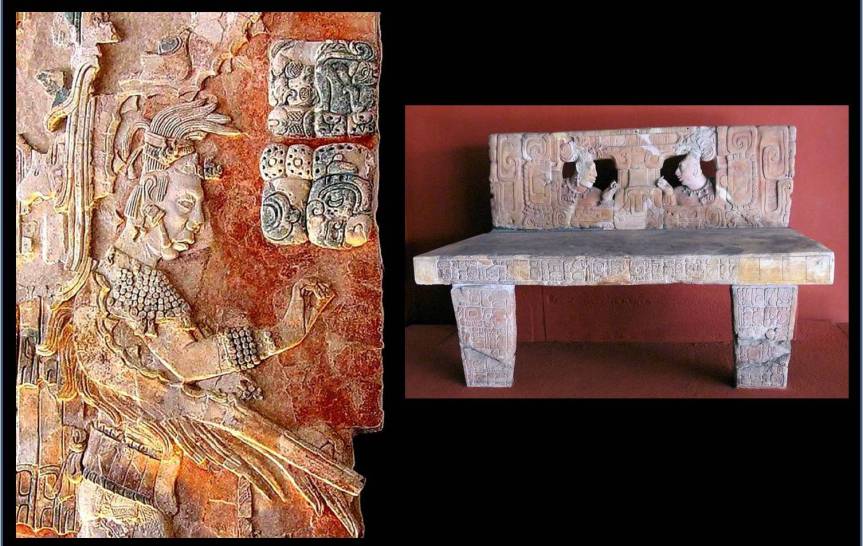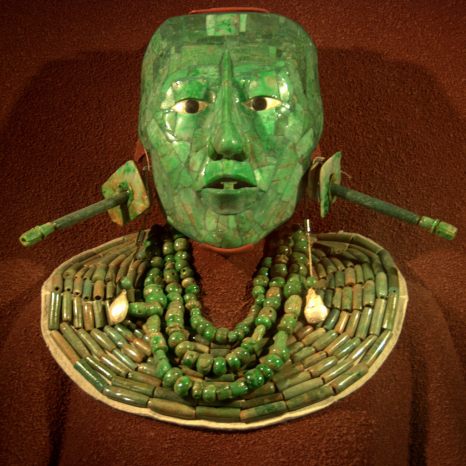Ancient Maya Art – Sculpture


The Monument 16 at Quiriguá, a Maya site located in the department of Izabal in south-eastern Guatemala. It is also known as Zoomorph P. Weighing over 20 tons and standing at 2m tall, 3.5m wide, and 3m long it is the largest of the “Zoomorfos” at Quiriguá. Every square-centimeter of this monument is engraved with information. Zoomorph P features the Maya ruler, Sky Xul. The piece was dedicated to him the 13th September 795 AD. Top: Front of Zoomorph P, mainly focus on the sacred Turtle with the ruler, Sky Xul, being born from it in a re-enactment of the birth of the First Father. Bottom: Back side of the Zoomorph P showing the image of the Cosmic Monster with a prominent headdress. He is also known as the Bird God and Itzamna.

Some examples of the carved lintels found at Yaxchilán (Chiapas, Mexico). Left: Lintel 25 carved in limestone, from 725 AD. Right: Lintel 24 also carved in limestone (Yaxchilán), from 725 AD.
In Copán, the characters were carved in high relief or round bulk, hieratic, and with bodies hardly distinguished under the heavy clothing and adornments; they also show the haughty chiefs who take prisoners, judge them, or sit upon slaves, represented in the violent scenes of Yaxchilán, Piedras Negras, and Bonampak; the lords with slender bodies, almost naked, and noble and delicate profiles that, in the low reliefs on stone and stucco found at Palenque, received with elegance and serenity the tokens of veneration from their subjects. All of these myriad of people must have really existed and, as an early example of the cult of personality, they wanted to self-glorify and left their effigies to posterity. The hieroglyphic text that accompanies these characters exposes information about their lives, their names, personal titles, dates of their birth and death, main events of their reign, names of relatives and successors…
 Left: Detailed of the polychromed bas-relief in the Palenque museum (Chiapas, Mexico) that depicts Upakal K’inich. Right: The Throne 1 of Piedras Negras now in the National Museum of Anthropology and History (Guatemala).
Left: Detailed of the polychromed bas-relief in the Palenque museum (Chiapas, Mexico) that depicts Upakal K’inich. Right: The Throne 1 of Piedras Negras now in the National Museum of Anthropology and History (Guatemala).
The large carved stone sarcophagus lid found at the tomb of Pakal the Great in the Temple of Inscriptions. This wonderful relief centers on the Mayan motif of “world trees”, a religious motif representing a colossal tree which supports the heavens, connecting them with the terrestrial world, and, through its roots, with the underworld. Around the edges of the lid is a band with cosmological signs, including those for sun, moon, and star, as well as the heads of six named noblemen of varying rank. The central image features a cruciform world tree. Beneath Pakal is one of the heads of a celestial two-headed serpent viewed frontally. Both the king and the serpent head on which he seems to rest are framed by the open jaws of a funerary serpent, a common iconographic device for signaling entrance into, or residence in, the realm of the dead. The king himself wears the attributes of the maize god (particularly a turtle ornament on the breast) and is shown in a peculiar posture that may denote rebirth.

Some examples of Maya sculpture. Left: Stucco portrait of Pakal the Great found at his burial in the Temple of Inscriptions of Palenque. Center: Stucco Maya portrait from the Classic-recent era (ca. 600 – 900 AD) found at the Chontal region of Comalcalco, state of Tabasco (Mexico). Right: The Queen of Uxmal carved in limestone, from the end of the Classic period, found at Uxmal (National Museum of Anthropology, Mexico City).

Maya sculpture applied to the architecture. Top: Mask of the rain god Chac at Codz Poop (El Palacio de los Mascarones, “Palace of the Masks”) at Kabah (south of Mérida state, Mexico). Bottom: Head of Kukulkán at the base of the west face of the northern stairway of El Castillo temple at Chichén-Itzá (Yucatán state, Mexico).
In the dry lands of Yucatán, where life depended on the benevolence of the rain god Chac (the rainfall supplier), it was necessary to pay him permanent homage to demonstrate the devotion of the population for his worship, and therefore the Maya covered the building’s facades with its mask thus detracting importance to representations of actual men, even their leaders, who were rarely represented in the Yucatecan monuments. The arrival of the Toltecs respected the all-powerful and indispensable Chac, but forced him to live on the facades along with Quetzalcóatl (called Kukulcán in Mayan), Tezcatlipoca, Tlalchitonatiuh, ‘Venusian’-style symbols, countless Toltec warriors, and also with multiple representations of concepts and ritual scenes typical of the art of central Mexico.
 Chacmools in Maya sculpture. Left: Chacmool at the top of the Temple of the 1000 Warriors at Chichén-Itzá. Right: Chacmool found at Chichén-Itzá (National Museum of Anthropology, Mexico City).
Chacmools in Maya sculpture. Left: Chacmool at the top of the Temple of the 1000 Warriors at Chichén-Itzá. Right: Chacmool found at Chichén-Itzá (National Museum of Anthropology, Mexico City).
The Funerary Ornaments of Kinich Janaab’ Pakal I (seventh century AD) found at his burial inside the Temple of Inscriptions in Palenque (National Museum of Anthropology, Mexico City). They included a jade mask and bead necklaces that were found covering his skeletal remains still lying in his coffin.
